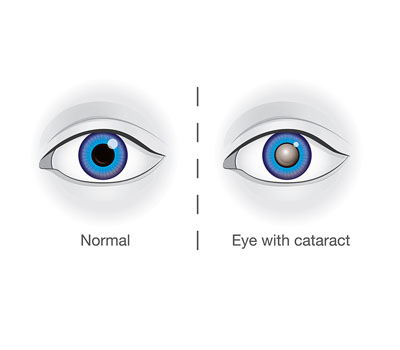
Cataract
Cataracts occur when the proteins in the lens of the eye begin to clump together, causing cloudiness and opacity that impairs vision. While cataracts are typically associated with aging, they can also develop due to other factors such as injury, medical conditions (e.g., diabetes), prolonged use of certain medications, or exposure to ultraviolet radiation.
Symptoms of cataracts may include:
- Blurry or Hazy Vision: Objects may appear blurry, cloudy, or less sharp than usual.
- Difficulty Seeing at Night: Vision may worsen in low-light conditions, making it challenging to drive or navigate dimly lit environments.
- Increased Sensitivity to Glare: Glare from lights, particularly when driving at night or in bright sunlight, may cause discomfort or difficulty seeing clearly.
- Faded or Yellowish Colors: Colors may appear faded, dull, or yellowed, affecting the perception of contrast and brightness.
- Frequent Changes in Eyeglass Prescription: Changes in vision may necessitate frequent updates to eyeglass prescriptions as cataracts progress.
- Double Vision: Cataracts can cause double vision or ghost images, especially in one eye.
- Halos Around Lights: Halos or rings may appear around lights, such as headlights or street lamps, due to light scattering caused by the cloudiness of the lens.
The primary treatment for cataracts is surgical removal of the cloudy lens and replacement with an artificial intraocular lens (IOL). Cataract surgery is a safe and effective procedure that can significantly improve vision and quality of life. Key aspects of cataract surgery include:
- Preoperative Evaluation: Comprehensive eye examination and assessment of overall health to determine the need for surgery and select the most suitable IOL.
- Surgical Procedure: Cataract surgery is typically performed on an outpatient basis under local anesthesia. The cloudy lens is removed using a technique called phacoemulsification, and an IOL is implanted in its place.
- Recovery: Most patients experience improved vision shortly after surgery, with minimal discomfort or downtime. It's essential to follow postoperative instructions, including using prescribed eye drops and attending follow-up appointments.
- Lifestyle Adjustments: After cataract surgery, patients may need to adjust to changes in vision and may require new eyeglass prescriptions. Adequate protection from UV radiation and regular eye exams are recommended to maintain eye health and prevent future vision problems.
Cataract surgery is one of the most common and successful surgical procedures performed worldwide, offering significant benefits for individuals with cataracts. With advancements in surgical techniques and IOL technology, patients can achieve clearer vision and an improved quality of life following cataract treatment. If you're experiencing symptoms of cataracts or have concerns about your vision, it's essential to consult with an eye care professional for evaluation and personalized treatment recommendations.
